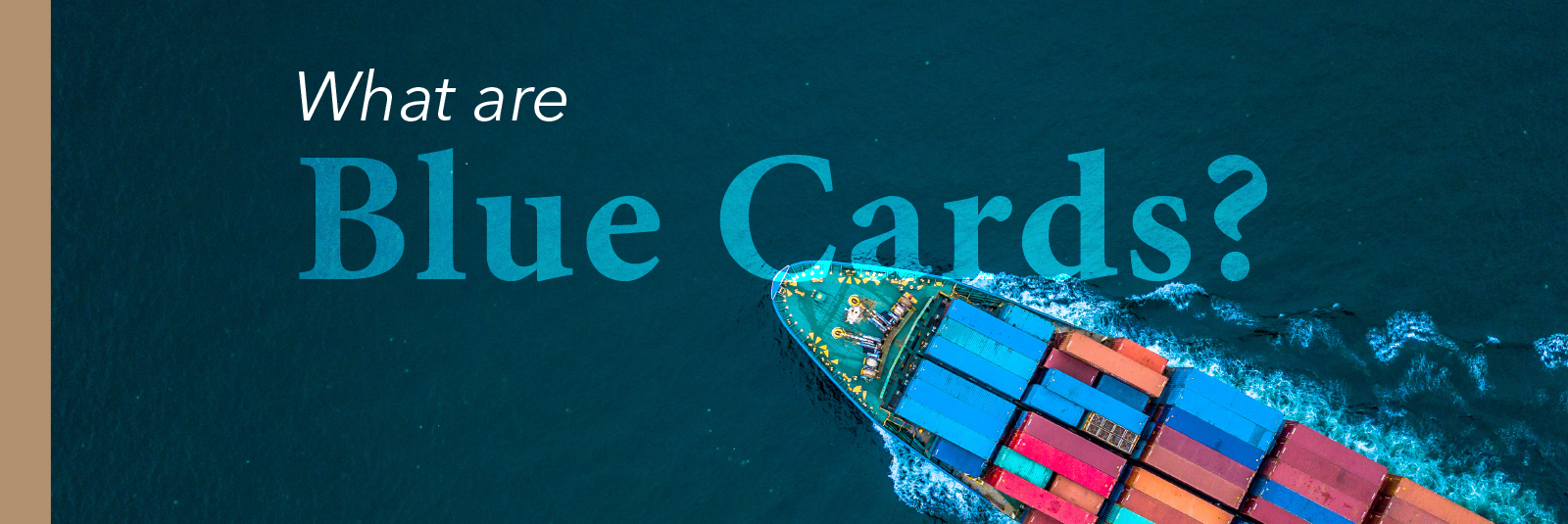A lot can happen when operating a ship, and that’s why insurance is a must for any shipowner. In fact, in some cases, certain forms of insurance are required, especially when pollution is involved. So how do you prove you have all the mandatory insurance policies in place? That’s where a Blue Card comes into play.
A Blue Card is essentially a stamp of approval, proving you have all the proper insurance policies regarding pollution damage.
History of Blue Cards
Blue Cards originated from The International Maritime Organization (IMO), which oversees numerous conventions and their protocols related to maritime safety, security, pollution, and liability and compensation. Liability and compensation conventions include:
- International Convention on Civil Liability for Oil Pollution Damage (CLC), 1969
- 1992 Protocol to the International Convention on the Establishment of an International Fund for Compensation for Oil Pollution Damage (FUND 1992)
- Convention relating to Civil Liability in the Field of Maritime Carriage of Nuclear Material (NUCLEAR), 1971
- Athens Convention relating to the Carriage of Passengers and their Luggage by Sea (PAL), 1974
- Convention on Limitation of Liability for Maritime Claims (LLMC), 1976
- International Convention on Liability and Compensation for Damage in Connection with the Carriage of Hazardous and Noxious Substances by Sea (HNS), 1996 (and its 2010 Protocol)
- International Convention on Civil Liability for Bunker Oil Pollution Damage, 2001
- Nairobi International Convention on the Removal of Wrecks, 2007
The International Convention on Civil Liability for Oil Pollution Damage outlined CLC liabilities and introduced the Blue Card. It determined that the owner of any oil tanker carrying more than 2,000 tonnes of oil cargo in bulk is liable for damages caused by any leaked or discharged oil, regardless of whether it was intentional or not. Shipowners that fall into this category must obtain a Blue Card, providing proof of insurance covering CLC liabilities.
Though similar to the CLC Convention, the Bunker Convention took it one step further when outlining pollution damage liabilities. It extended them to include any ship over 1,000 gross tonnage, not just oil tankers. It also specifically addressed pollution caused by leaked or discharged bunker oil. Unlike cargo oil, bunker oil is stored in a ship’s bunkers and used to fuel the ship.
The Bunker Convention assigns liability to the shipowner for pollution damage from a ship’s bunkers, therefore, legally requiring shipowners to have liability insurance. This led to the Bunker Blue Card, which provides proof that a shipowner has insurance coverage that will fully meet the liability claims set out in the Bunker Convention.
Any ship docking at a port in one of the participating countries must have a Bunker Blue Card from their marine insurer. There are 21 countries that currently require a Bunker Blue Card:
- The Bahamas
- Bulgaria
- Croatia
- Cyprus
- Estonia
- Germany
- Greece
- Jamaica
- Latvia
- Lithuania
- Hungary
- Luxembourg
- Norway
- Poland
- Samoa
- Sierra Leone
- Singapore
- Slovenia
- Spain
- Tonga
- United Kingdom
How to Apply for a Blue Card
Now that you understand what a Blue Card is, how do you get one? The general process is simple:
- Shipowner applies for a Blue Card from their marine insurance provider
- Marine insurer verifies the shipowner has all the compulsory insurance coverage and provides the shipowner with a Blue Card
- Shipowner submits that Blue Card to their flag state (or other applicable institution) to obtain a Certificate of Insurance
(Shipowners obtain Certificates of Insurance from the state where their vessel is registered. Some flag states will issue Certificates to shipowners registered in a different flag state, but many will not.)
A Blue Card typically includes the vessel:
- Name
- Call sign
- Port of registry
- IMO number
- Name and address of the registered owner’s principal place of business
If you wish to visit a port in a flag state that is a party to the Bunker Convention, you must apply for a Blue Card from your insurance company in advance. Be sure to choose a reliable insurance partner like Safe Harbor that is approved by over 30 countries and can easily provide you with a Bunker Blue Card.





